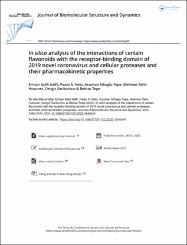| dc.contributor.author | İstifli, Erman Salih | |
| dc.contributor.author | Netz, Paulo A. | |
| dc.contributor.author | Şıhoğlu Tepe, Arzuhan | |
| dc.contributor.author | Hüsunet, Mehmet Tahir | |
| dc.contributor.author | Sarıkürkçü, Cengiz | |
| dc.contributor.author | Tepe, Bektaş | |
| dc.date.accessioned | 2021-05-05T22:14:05Z | |
| dc.date.available | 2021-05-05T22:14:05Z | |
| dc.date.issued | 2020 | |
| dc.identifier.issn | 0739-1102 | |
| dc.identifier.issn | 1538-0254 | |
| dc.identifier.uri | https://doi.org/10.1080/07391102.2020.1840444 | |
| dc.identifier.uri | https://hdl.handle.net/20.500.12933/282 | |
| dc.description | Istifli, Erman Salih/0000-0003-2189-0703; TEPE, Bektas/0000-0001-8982-5188; Netz, Paulo/0000-0003-4242-0591; SIHOGLU TEPE, Arzuhan/0000-0001-8290-9880; Sarikurkcu, Cengiz/0000-0001-5094-2520 | en_US |
| dc.description | WOS:000584797200001 | en_US |
| dc.description | PubMed: 33111622 | en_US |
| dc.description.abstract | Coronavirus Disease 2019 (COVID-19) has infected more than thirty five million people worldwide and caused nearly 1 million deaths as of October 2020. The microorganism causing COVID-19 was named as Severe Acute Respiratory Syndrome Coronavirus 2 (SARS-CoV-2 or 2019-nCoV). The aim of this study was to investigate the interactions of twenty-three phytochemicals belonging to different flavonoid subgroups with the receptor binding domain (RBD) of the spike glycoprotein of 2019-nCoV, and cellular proteases [transmembrane serine protease 2 (TMPRSS2), cathepsin B and L (CatB/L)]. The compounds interacted more strongly with CatB and CatL than with the other proteins. Van der Waals and hydrogen bonds played an important role in the receptor-ligand interactions. As a result of RBCI (relative binding capacity index) analysis conducted to rank flavonoids in terms of their interactions with the target proteins, (-)-epicatechin gallate interacted strongly with all the proteins studied. The results obtained from molecular dynamics and molecular mechanics Poisson-Boltzmann surface area (MM/PBSA) methods also supported this data. According to Lipinski's rule of five, (-)-epicatechin gallate showed drug-likeness properties. Although this molecule is not capable of crossing the blood-brain barrier (BBB), it was concluded that (-)-epicatechin gallate can be evaluated as a candidate molecule in drug development studies against 2019-nCoV since it was not the substrate of P-gp (P-glycoprotein), did not inhibit any of the cytochrome Ps, and did not show AMES toxicity or hepatotoxicity on eukaryotic cells. | en_US |
| dc.description.sponsorship | CNPqNational Council for Scientific and Technological Development (CNPq); CAPESCAPES [001]; Centro Nacional de Supercomputacao (CESUP), Universidade Federal do Rio Grande do Sul (UFRGS) | en_US |
| dc.description.sponsorship | P. A. N. acknowledges financial support from CNPq and CAPES (Financial code 001), as well as the Centro Nacional de Supercomputacao (CESUP), Universidade Federal do Rio Grande do Sul (UFRGS) for providing HPC resources. | en_US |
| dc.language.iso | eng | en_US |
| dc.publisher | Taylor & Francis Inc | en_US |
| dc.rights | info:eu-repo/semantics/openAccess | en_US |
| dc.subject | COVID-19 | en_US |
| dc.subject | flavonoid | en_US |
| dc.subject | molecular docking | en_US |
| dc.subject | molecular dynamics | en_US |
| dc.subject | MM | en_US |
| dc.subject | PBSA | en_US |
| dc.title | In silico analysis of the interactions of certain flavonoids with the receptor-binding domain of 2019 novel coronavirus and cellular proteases and their pharmacokinetic properties | en_US |
| dc.type | article | en_US |
| dc.department | AFSÜ, Eczacılık Fakültesi, Temel Eczacılık Bilimleri Bölümü | en_US |
| dc.contributor.institutionauthor | Sarıkürkçü, Cengiz | |
| dc.identifier.doi | 10.1080/07391102.2020.1840444 | |
| dc.relation.journal | Journal Of Biomolecular Structure & Dynamics | en_US |
| dc.relation.publicationcategory | Makale - Uluslararası Hakemli Dergi - Kurum Öğretim Elemanı | en_US |
















